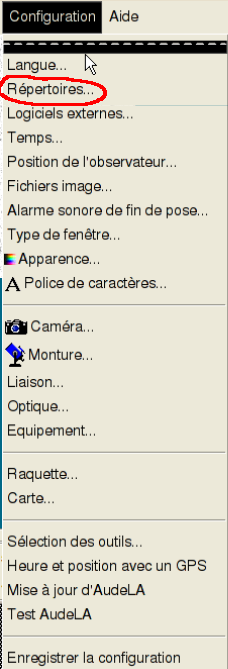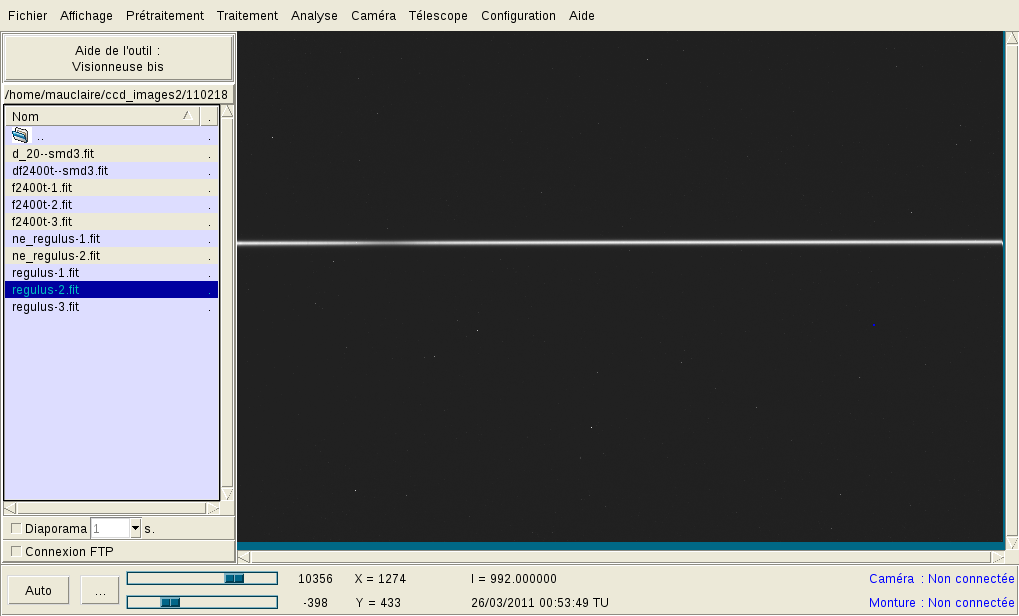
 |
Use of Pipeline 1 for the computation of the instrumental response |
SpcAudace |
![]()
1. Configuration and preliminary tunings in Audela

Use "..." to reach the desired directory.

Beware: all the data to be processed ( 2D spectral images (including those associated with the calibration lamps), darks, flats, darks associated with the flats, offsets (if relevant)) must be located in this directory.

By clicking on a file, it will be displayed. You can also use the keyboard Up and Down buttons to navigate from one file to its neighbours.

It is preferable to uncheck the automatic threshold
adjustment. In this end, click on the "..." button, just left to the
cursors used for the tuning of the thresholds:


![]()
2. Launch the pipeline dedicated to the computation of the instrumental response
Using the spectrum of the 3 proposed reference stars (Regulus, Altair and Castor) allows a straightforward computation of the instrumental response. This is illustrated below, using the spectrum of Regulus.

From the Pipelines menu, click on "Pipeline 1". The pipeline number 1 window shows up:

![]()
3. Fill the associated form



![]()
4. Computational options
The remaining of the form concerns different options to be specified for the computation. The default settings are appropriate for most of the cases you will encounter. They rarely have to be changed, especially for high resolution spectroscopy. Thus the information in this section is mainly given for sake of completeness.
The method "med" gives best results in most cases.
Method "rober" turns out to be the most effective.
Click on "OK" pour launch the pipeline.
It starts with a smilex correction of the lines in the calibration image. Next, it preprocesses the raw images and after that, it opens a new window dedicated to the spectal calibration. This is the only stage where the user has to provide additional information.
![]()
5. Spectral calibration
At this stage, the profile computed from the calibration images is displayed in the SpcAudace window:
However this profile is not calibrated in wavelength. To achieve spectral calibration, several lines in this profile are to be matched with the wavelength of the lines in the (neon in the case of a LHIRES3 spectrograph) calibration lamp. To user is implied for specifying this match. To help the user in this task, an annotated image of the neon spectrum is displayed in Audela's Visu 1 window:
It is then straightforward to match the lines in the uncalibrated profile with those of the neon lamp. In our example, three lines, with almost equal separation and with increasing intensities are to be found. You will recognize lines with wavelenghts 6532.93 A, 6598.95 A et 6678.28 A.
Matching the main lines in the profile, which are automatically detected by SpcAudace, and neon wavelengths is achieved through the calibration window:
By clicking on the downward pointing arrow, rignt to the empty boxes, on the lines "Longueur d'onde associée à la raie n° X" (wavelength associated with line number X), you can span the wavelengths specific of each chemichal element. "NeI" corresponds to neon. Using the accurate wavelengths available from the library allows an accurate calibration.
If one of the lines in the profile is not detected, it is possible to enter its location (in pixels) through the keyboard: just place the mouse in the center of the line and look at the value displayed below the image. In order to keep accuracy it is highly recommended to zoom the SpcAudace window.
It is mandatory to keep the wavelength boxes associated with lines that SpcAudace may have erroneously detected empty. These lines will then be ignored.
In our example, only lines with coordinates 1361.0, 659.96 and 97.558 pixels are paired with wavelengths. The pixel coordinates may show slight variations for different runs of the pipeline. This stems from slight variations in the geometrical corrections since the pipeline is adaptative according to how the spectrograph is blended.
The pixel coordinate to wavelength map (calibration map) is modeled by a low degree polynomial. Its degree depends on how many lines you have selected:
- with two rays (minimum required), first degree polynomial;
- with three rays, second degree polynomial;
- with four rays or more, third degree polynomial;
In the end, the pipeline produces profiles that are regularly sampled in wavelength: an interpolation is then required unless the polynomial was first degree (this interpolation is inproperly called "linéarisation de la loi de calibration"). This allows these profiles to be read by all astromical softwares.
Next click on "OK" to launch the last computations. The pipeline then completes spectral data reduction and produces profiles up to level 1c. The pipeline also displays three different possible instrumental responses.
![]()
6. The pipeline run
You can inspect the progress in the pipeline computations through Audela's console. The different steps of these computations are:
- Preprocess of raw images. This includes the computation of a master dark and of a master flat. The master dark is obtained by selecting the median value for each pixel.
- Geometrical corrections:
- Correction for the smilex.
- Correction for tilt.
- Vertical registration.
- Horizontal registration (whenever 2 calibration images are available).
- Stack (summation) of the so-corrected images.
- Sky background estimation and subtraction.
- Binning of columns to produce a spectral profile.
- Application of the computed calibration map to the profile of the reference star (here Regulus).
- Estimation of 3 possible instrumental responses.
- Correction for the instrumental response using the default instrumental response.
- Regular resampling (in wavelength) of the profile .
- Display of the final profile in the SpcAudace window.
Display of the final (level 1c) profile in the SpcAudace window.
![]()
7. Choosing the instrumental response
The 3 computed instrumental responses are saved in files: reponse_instrumentale-1.fit, reponse_instrumentale-2.fit and reponse_instrumentale-3.fit. These instrumental responses are obtained by applying different filters to the result of the division of the level 1b profile by the catalogue profile of the star.
The pipeline displays these 3 instrumental responses (in red) superimposed with the result of the division (in blue):
reponse_instrumentale-1.fit reponse_instrumentale-2.fit reponse_instrumentale-3.fit reponse_instrumentale-3 best matches the result of the division while keeping very smooth. This the most frequent situation and this instrumental response has been used (default setting) for the computation of the level 1c profile of Regulus displayed above. This instrumental response is the one to be used for correcting the spectral data acquired with the same instrumentation.
==> See tutorial for Pipeline 2a for the reduction of stellar high resolution spectral data.